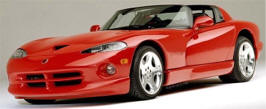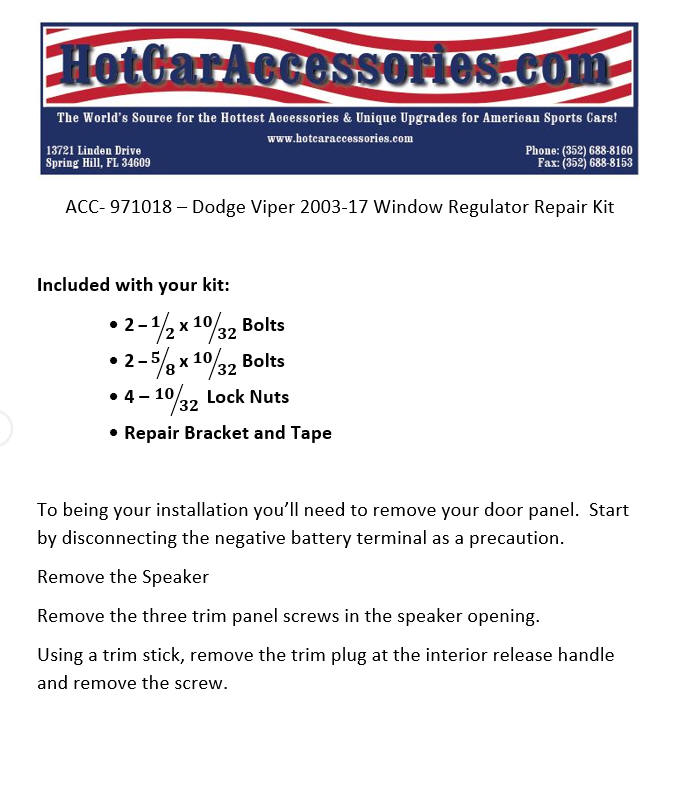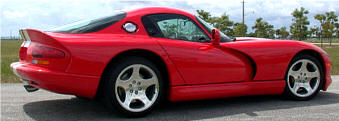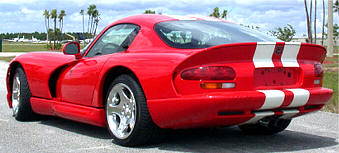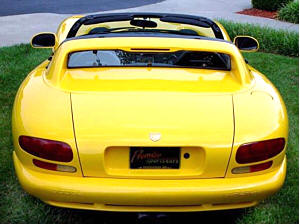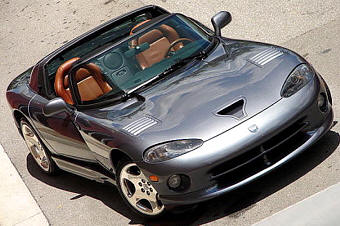|

Dodge Viper
RT-10 Convertible 1997-2002 * Dodge Viper
GTS Coupe 1996-2002
A coupe model called the GTS was also
introduced in 1996. Dubbed the "double bubble", the roof featured
slightly raised sections above each seat to accommodate usage of
helmets, a throwback to its intended purpose. Indeed, the
Viper's performance has made the vehicle popular for both
amateur and professional racers. Vipers can be seen
participating often in drag racing, road racing and drifting.
The GTS, like its predecessor, was chosen as the pace car
for the 1996 Indianapolis 500.
Second
generation models were upgraded bringing increased engine power,
an improved suspension, and reduced braking distances; the 1996
to 2002 Viper GTS had a 450 bhp (336 kW) engine, which could
complete the quarter mile 0.7 seconds faster and increased top
speed by 35 km/h (22 mph) or so.
Along with the updated performance came the
inclusion of some of the "luxuries" the car did without before.
Dual front airbags were added to the vehicle's safety equipment
list in 1997 as mandated by the government. The car was also
exported to Europe, where it was re-badged as a Chrysler, and
sold under this marquee from 1997 to 2003.
In the first six years of production almost
10,000 Vipers were sold. Minor evolutionary changes including
new 18" diameter wheels were introduced in the 1999 model.
Subsequent versions featured light-weight hypereutectic pistons
and an improved exhaust system. 1999 saw the introduction of the
Cognac Connolly interior package. Continuing the refinements, an
ABS system was introduced in 2001. In 2002, the end of second
generation production was celebrated with the release of 360
commemorative "Final Edition" models. These models were painted
red with white stripes, paying tribute to the famous
race-winning Oreca cars.
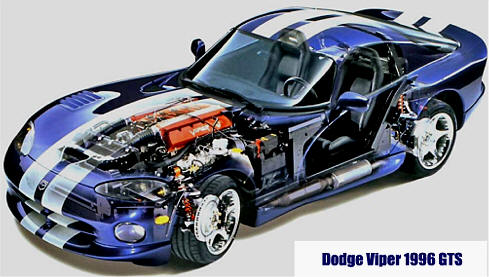
Performance (GTS):
0-60: 4.0 sec.
0-100: 8.6 sec.
quarter mile: 12.2 sec @ 118 mph (190 km/h)
top speed: +190 mph (306 km/h) (again proven by Road and Track
magazine)
Slalom: 71.3 mph (115 km/h)
skidpad average g: .98
|
Production |
1996–2002 |
|
Body style(s) |
2-door roadster 2-door coupe |
|
Engine(s) |
8.0 L V10 450 hp (336 kW) |
|
Transmission(s) |
6-speed manual |
|
Wheelbase |
96.2 in (2443 mm) |
|
Length |
175.1 in (4448 mm) (1996-99 RT/10)
176.4 in (4481 mm) (2000-02 RT/10)
176.7 in (4488 mm) (GTS) |
|
Width |
75.7 in (1923 mm) |
|
Height |
44 in (1118 mm)(RT/10)
47 in (1194 mm) in (GTS) |
Back to Top of
Page - Click Here

1996 Year of the
Dodge Viper GT Coupe
The 1996 Dodge Viper brought forth some major changes in this muscle car
institution since its inception in 1992. First and foremost, the once solitary
beast has split into two models: the standard RT/10 roadster and now the GTS
coupe. Both 1996 Dodge Vipers seem to have found some more of that power
that owners seemed greedy for from the 8.0-liter, V10 engine. The roadster has
a maximum output of 415 hp, but the GTS manages to get a whooping 450 hp from
the standard engine.
The GTS was even released with some new features, above and beyond the optional
air conditioning that came in earlier models of the Viper. AC comes standard in
the 1996 Dodge Viper GTS, as do power windows, power door locks and air
bags. Dodge also thought of the taller and shorter drivers with the 1996 Viper
GTS, and put in adjustable foot pedals. Gas mileage isn't too shabby for the
Dodge Viper, either: 13/21 (city/highway) mpg for the roadster, and 13/24 mpg
for the GTS.
Owners of the 1996 Dodge Viper are fanatical, and only consistently want one
thing fixed: more power! People who picked up a 1996 Dodge Viper GTS love the
standard features, but people with the roadster don't seem to be complaining.
1997
This year, it was the 1997 Dodge Viper RT/10 Roadster that got the upgrade, and
designers took their cues from the GTS. First and foremost, the standard
8.0-liter, V10 engine in the Roadster was upgraded to meet the 450 hp the GTS is
capable of. Air conditioning, power windows, power door locks and
a CD player come standard now in the 1997 Dodge Viper Roadster, previously only
available (except AC) in the 1996 Dodge Viper GTS. In addition, the 1997 Dodge
Viper Roadster comes with a standard hard-top, though most people had been
getting one in previous years anyway.
What does this mean for the 1997 Dodge Viper? Well, now all of the comfort and
extra power of the GTS can be had with the fun and feel of being in a
convertible. The loud side-pipes that the Dodge Viper Roadster had become known
for are now gone, replaced by the quieter rear-exhaust system of the GTS, making
all 1997 Dodge Vipers more compliant with new noise laws many states have. What
began as a car for the power hungry tough guy uninterested in comfort has
emerged in 1997 as a sports car that the masses can enjoy, though driving a car
this powerful is not a task for a true speed novice.
Owners of the 1997 Dodge Viper are thrilled about the newfound power that they
had been asking for since 1992, and about all of the standard options
available. The 1997 Dodge Viper is a pamper-mobile compared to previous years,
but hasn't lost anything, even gained some power.
1998
The 1998 Dodge Vipers rolled off of the assembly almost identical to what they
were in 1997. After all, why change so soon the perfect muscle car? With a
8.0-liter, V10 engine producing 450 hp in both the Viper RT/10 Roadster and the
Viper GTS, either 1998 Dodge Viper is capable of out-performing virtually
every other car on the road. With a 0-60 mph in the low 4 seconds (claims of
3.9 have been made by owners), the Viper is built for speed and acceleration,
though newer models like the 1998 do include some comfort features like air
conditioning, power windows and locks, and a CD player to motivate you while
you're going fast.
With one of the most unique and recognizable body styles in the automotive
world, the 1998 Dodge Viper is a head-turner everywhere it goes. Expect to be
the object of everyone's attention when you stop at red lights. Good thing the
1998 Dodge Viper is built for impressing off the line! Unfortunately, 1998 was
one of the Dodge Viper's low years for gas mileage, at 12/21 mpg city/highway
for both models.
Owners of the 1998 Dodge Viper talk about little else than the sheer power,
speed and acceleration that the 1998 Dodge Viper has at its
fingertips. Basically a street legal racecar, with its 6-speed manual
transmission, the Viper is a bit of a beast to handle if you don't know what
you're doing. One continual request owners make, however, despite the 450 hp
already available in the 1998 Dodge Viper, is more power.
1999
The 1999 Dodge Viper welcomes a new member to the muscle-car family: the 1999
Dodge Viper ACR (American Club Racer). This very limited edition (less than 200
were made) hybrid of the GTS is proof once more that Dodge can continue to
deliver the unthinkable: more power to its most powerful sports car.
That's right, through some engine tweaks and removal of comforts, the 1999 Dodge
Viper ACR has managed to shed 60 lbs and gain 10 hp over the Roadster and GTS
from the 8.0-liter V10, for a staggering 460 hp! But don’t worry. If you can't
get your hands on an 1999 Dodge Viper ACR, the Viper RT/10 Roadster and the
Viper GTS are more than enough car for anyone.
Both come full of features not available in the early Dodge Viper models, like
air conditioning, power windows and locks, and a CD player. With a 0-60 mph
consistently in the low 4 seconds, the 1999 Dodge Viper is a car that can give
you, and the people trying to catch a glimpse of its beauty from the sidewalk,
whiplash. Gas mileage is low, especially city, at 12/21 mpg (city/highway), but
how many people buy a Dodge Viper for its efficiency or practicality?
The people who have bought 1999 Dodge Vipers are fanatical about the raw power
and speed, as well as the rockstar-ish head turning ability that the Viper seems
to possess. They generally seem to be in agreement: the Dodge Viper is the
greatest street-legal sports car on the market. But they still want more power.
2000
The 2000 Dodge Viper continued the tradition of the near identical dual-styles,
the RT/10 Roadster and the GTS Coupe, both with 8.0-liter V10 engines that pump
out a staggering 450 hp. But if that's not enough power, Dodge also continued
producing a limited number of ACR (American Club Racer) Vipers,
a stripped down and modified GTS that has 460 hp. Basically, the 2000 Dodge
Viper ACRs are street legal racecars, even more-so than the other Vipers have
been for years.
The comfort levels of the 2000 Roadster and the 2000 GTS Coupe are more than
adequate for the appropriate use of the Dodge Viper: going fast. With air
conditioning, power windows and locks, and a decent CD player/sound system, the
2000 Dodge Viper will keep you happy as you go barreling down the road at
whatever ticket-inducing speed you feel comfortable driving. With a 0-60 mph of
about 4 seconds, the 2000 Dodge Viper is one of the fastest stock cars
available. The gas mileage for this beast of the road is about what you’d
expect: 12 mpg city and 21 mpg highway.
Time and time again, owners of the 2000 Dodge Viper (and all Dodge Vipers) talk
about the skill required to drive this car. It is fast. It is powerful. It
can make all of your driving fantasies come true. But the 2000 Dodge Viper is
not a car for beginners. That having been said, few cars out there can give you
as much power at your fingertips
2001
The 2001 Dodge Viper came out of the factory with an important, and somewhat
revolutionary, change: a 4-wheel anti-lock brake system. Even more than the
comforts that had been added over the previous few years, this new brake system
takes a step towards taming the beast that is the Dodge Viper, and
making it a bit nicer for the average driver to handle. But with this safe
addition, no power has been lost from any model of the 2001 Dodge Viper. The
8.0-liter V10 engine still has the power of 450 horses (460 in the ACR package),
and proper use of the 6 speed manual transmission can have this monster of the
road up to 60 mph in around 4 seconds.
Air conditioning, power locks and windows, and airbags all come standard in the
2001 Dodge Viper RT/10 Roadster and GTS Coupe models. Gas mileage is still not
terribly impressive, at 11/21 mpg city/highway, but let's face it. If you buy a
2001 Dodge Viper, you probably don’t care too much about gas mileage; you're too
interested in going fast.
Owners of the 2001 Dodge Viper can talk about little else besides the shear
power and speed an experienced driver can suck out the engine, and the
unparalleled head-turning ability the Viper exhibits. Owner reviews tend to be
along the lines of “Greatest car ever!” According to most owners, the 2001
Dodge Viper is the greatest American muscle car ever made.
2002
The 2002 Dodge Viper is the last car in an era, the era of the original Dodge
Viper style. As such, almost nothing is different about the 2002 Dodge Viper
from the 2001. Both the 2002 Dodge Viper Roadster and GTS have massive
8.0-liter V10s under the hood that harness the power of 450 horses, allowing
the Dodge Viper to have almost unparalleled speed and acceleration. With a 0-60
mph of the low 4 seconds, the Dodge Viper can out-drag any car you're likely to
meet at the light.
The 2002 Dodge Viper still has all of the standard features Viper owners have
become used to: air conditioning, power windows and locks, airbags, and
anti-lock brakes (introduced in 2001). Fuel mileage is also the same, 11/21
mpg, low, but at least Dodge is consistent here. They know what their drivers
want, and that's power, power, and power. Dodge didn't let them down with the
2002 Viper.
Owners of the 2002 Dodge Viper have very focused minds. They almost unanimously
adore the pure speed and acceleration of the Viper, many making claims to top
speeds around 200 mph. Most Viper owners are also huge fans of the head-turning
ability the unique shape and sound of the 2002 Dodge Viper have. This is a
muscle car created to make other cars look bad. It may not be practical, but it
sure is fun.
|

